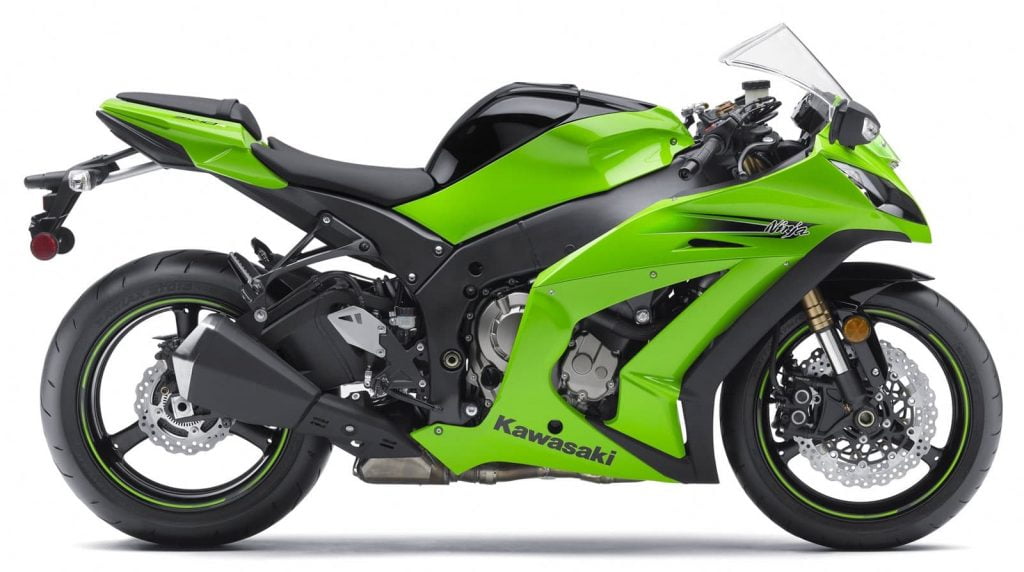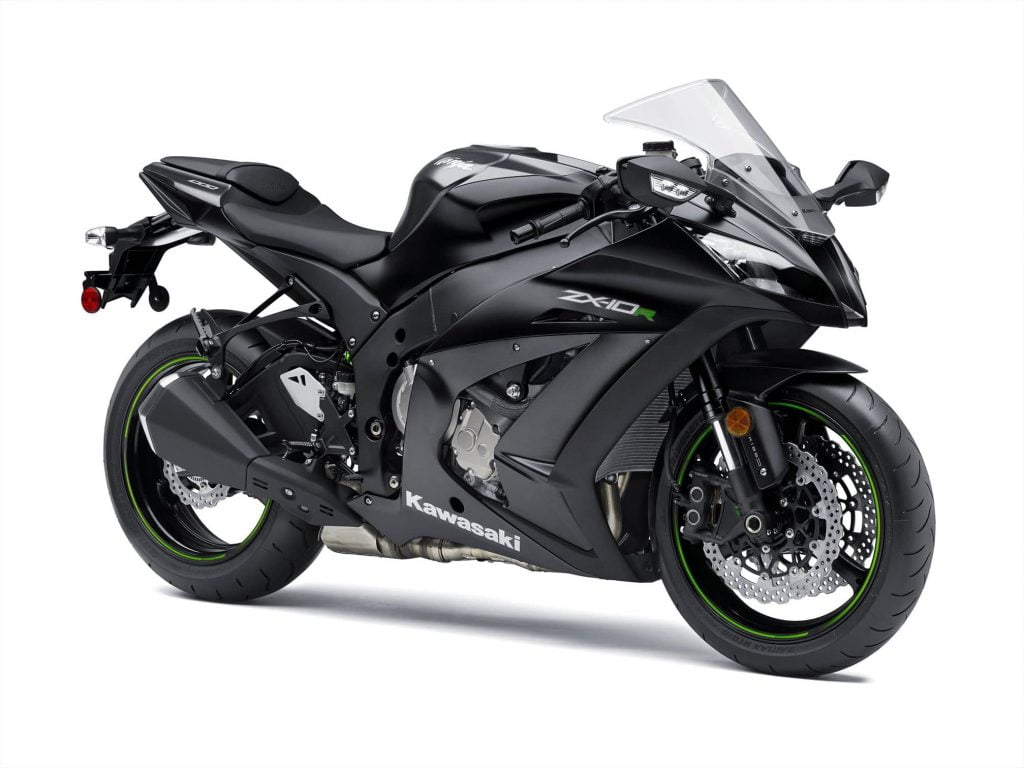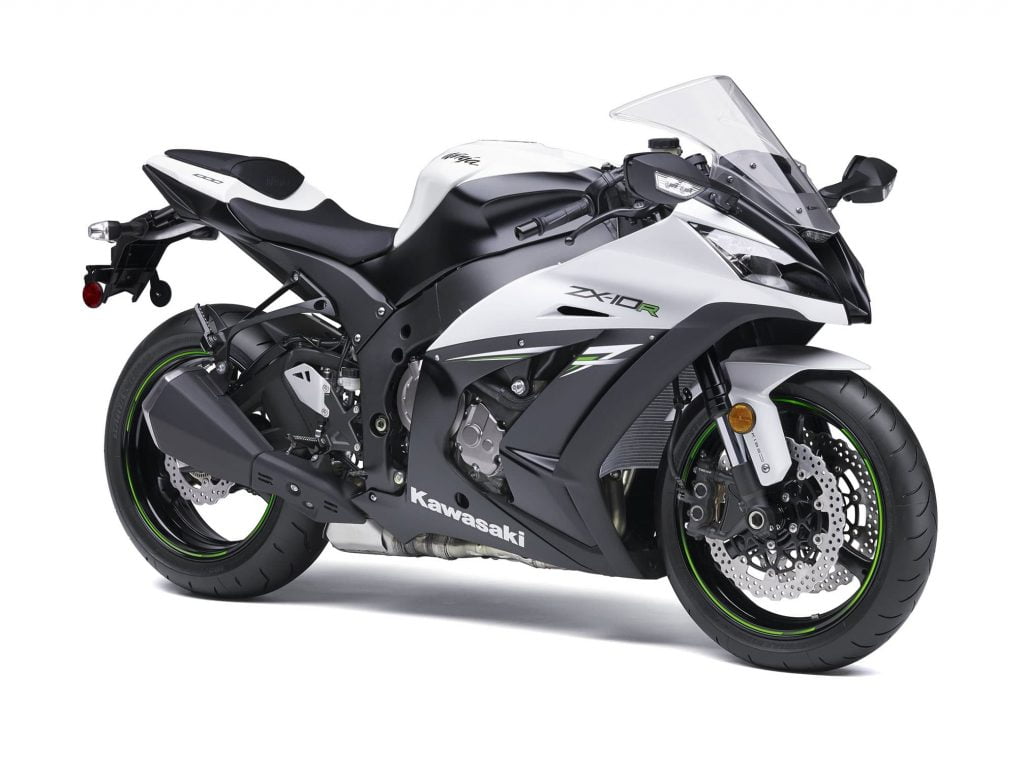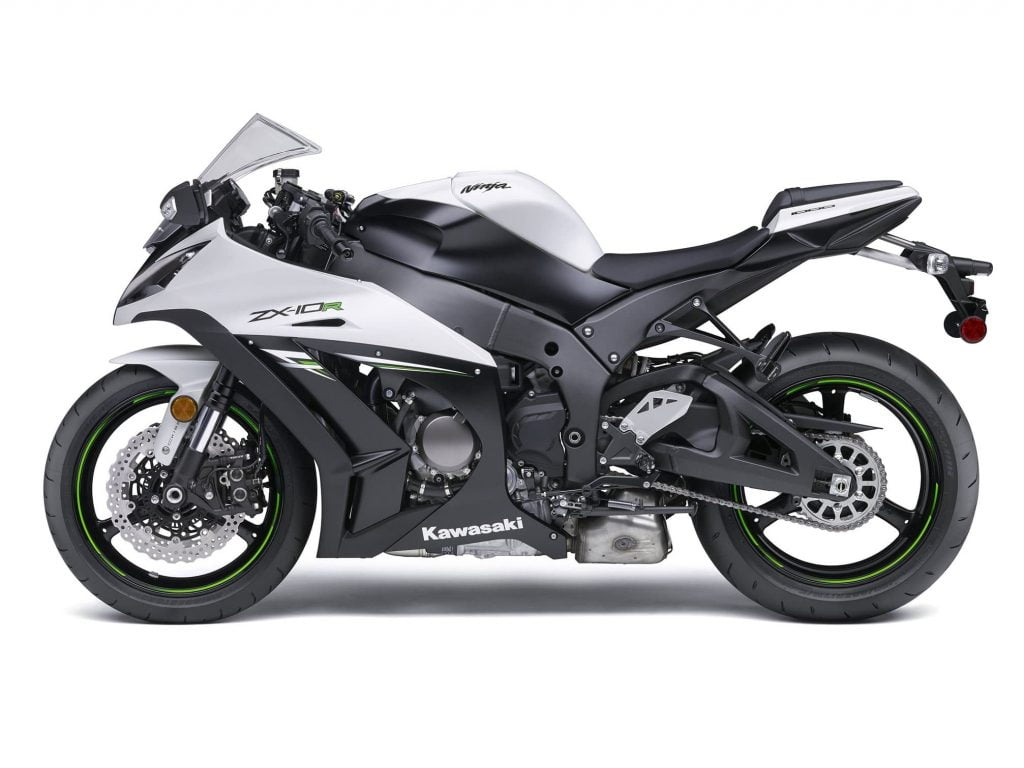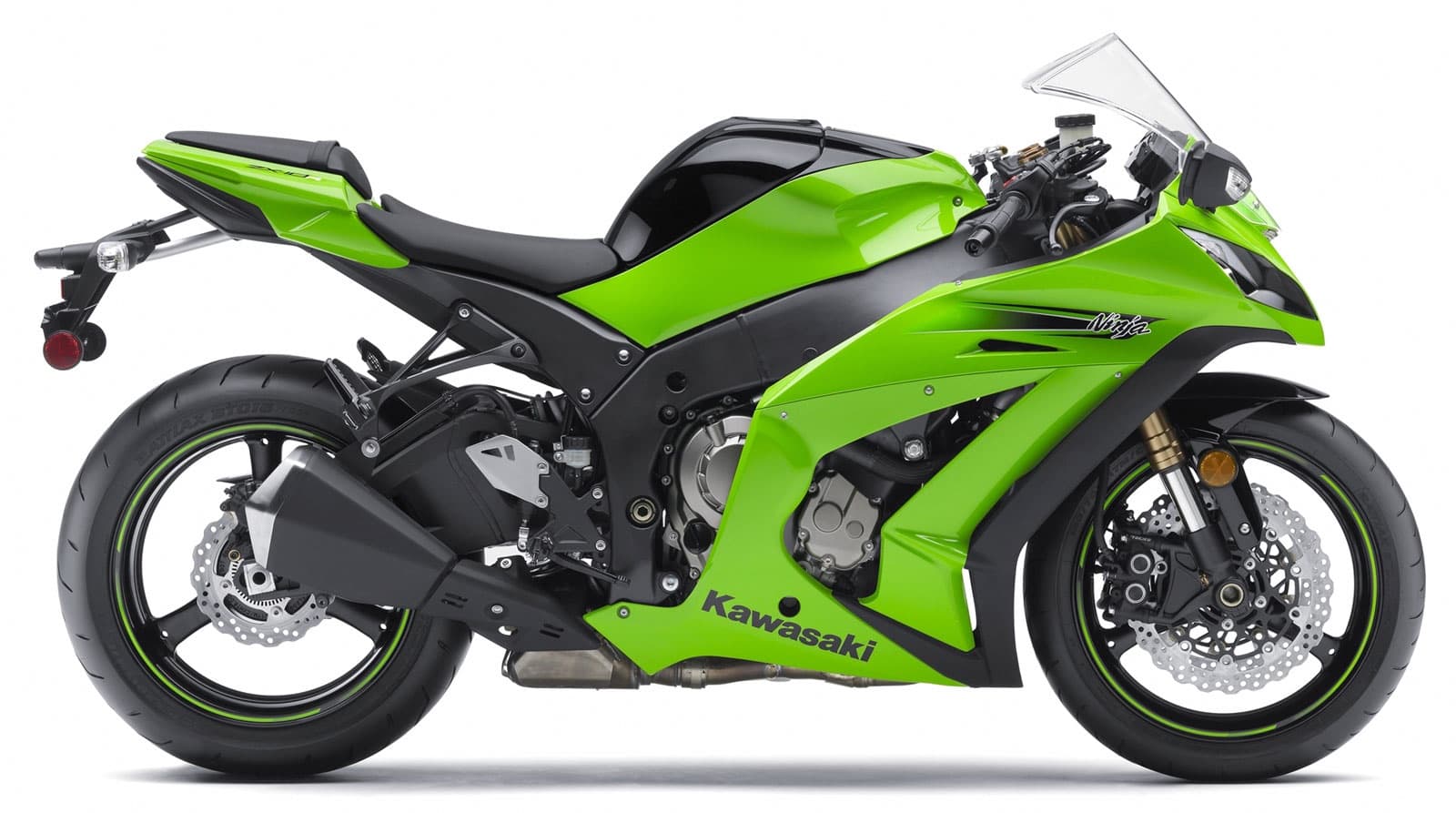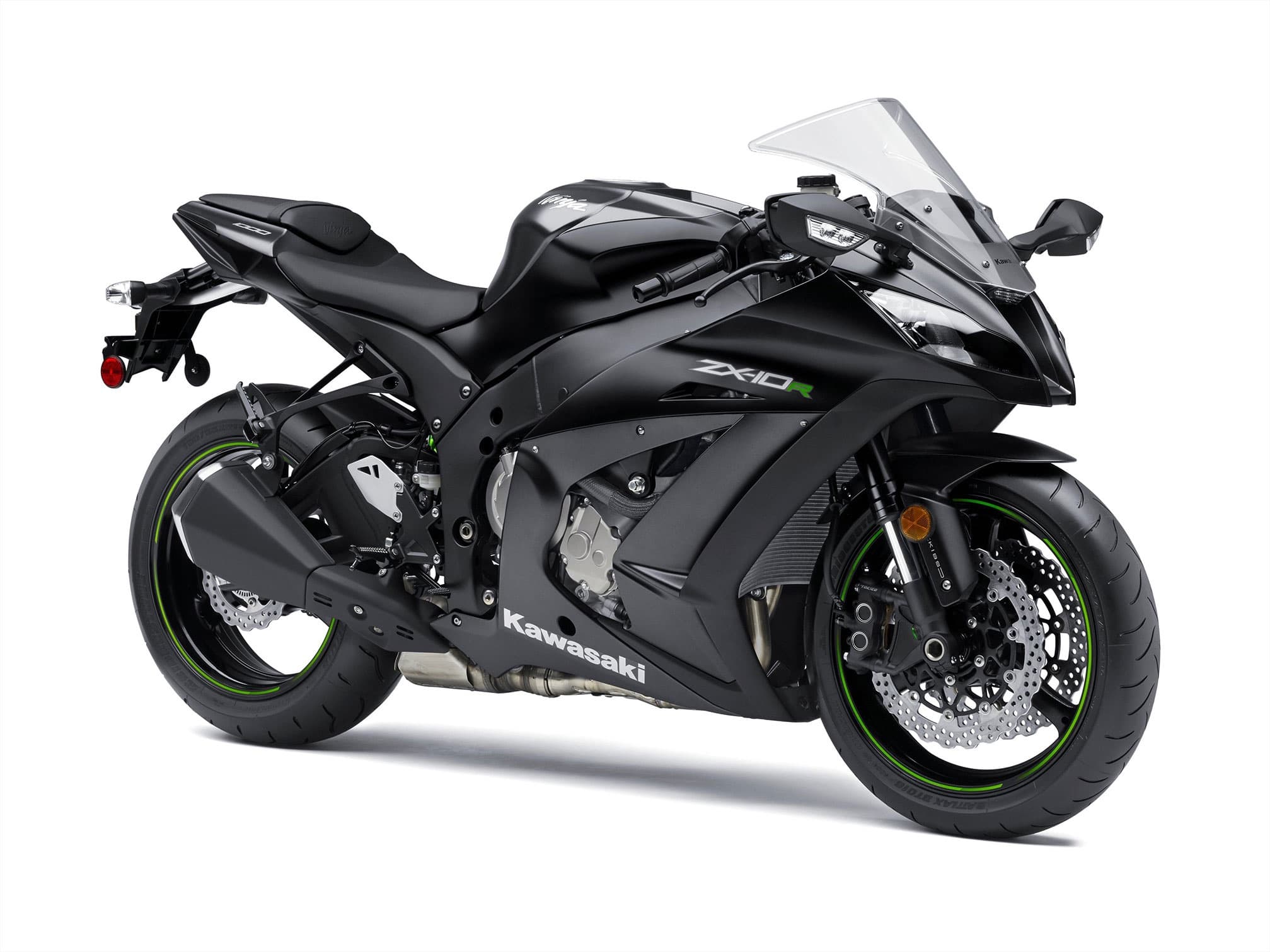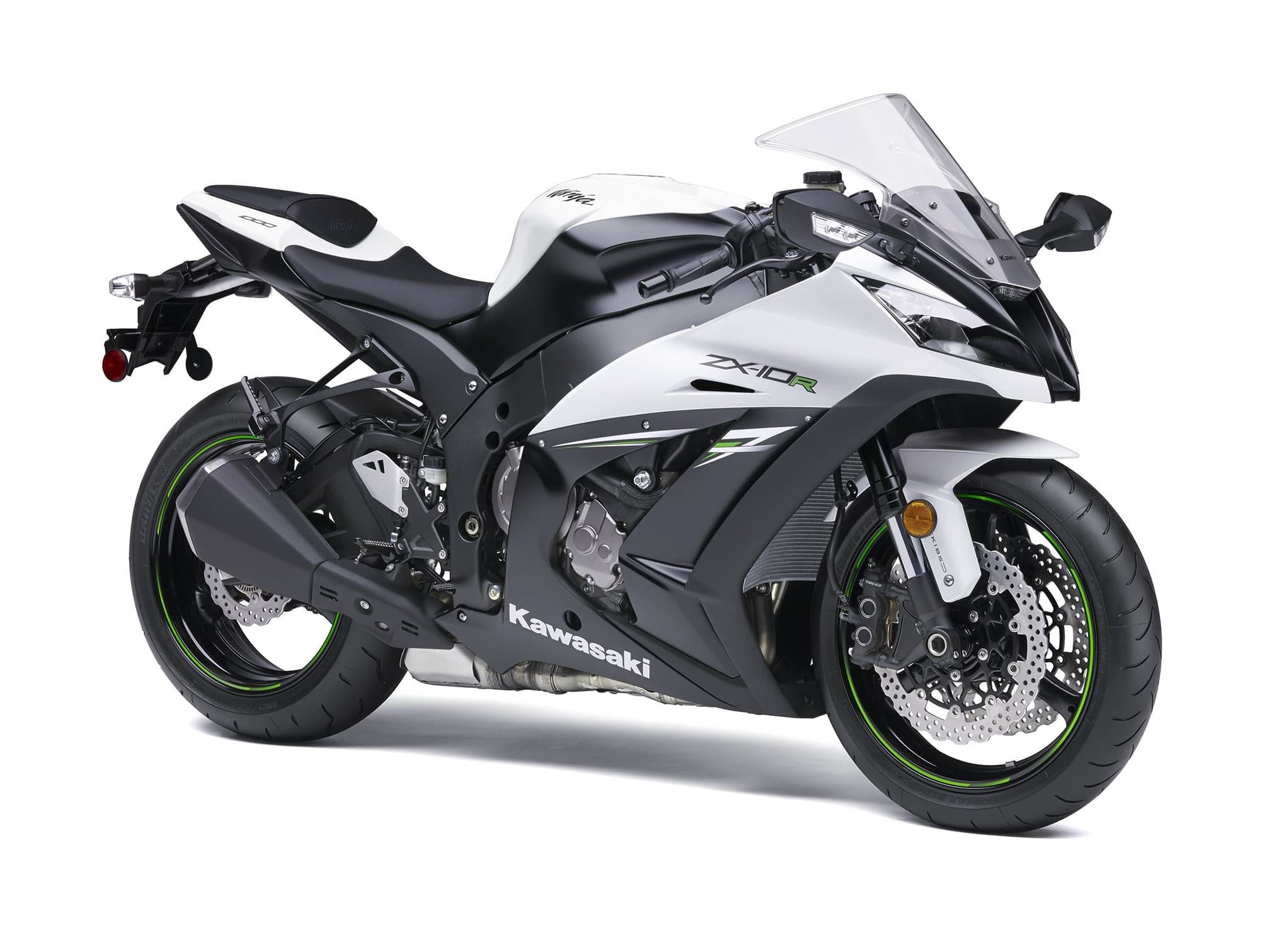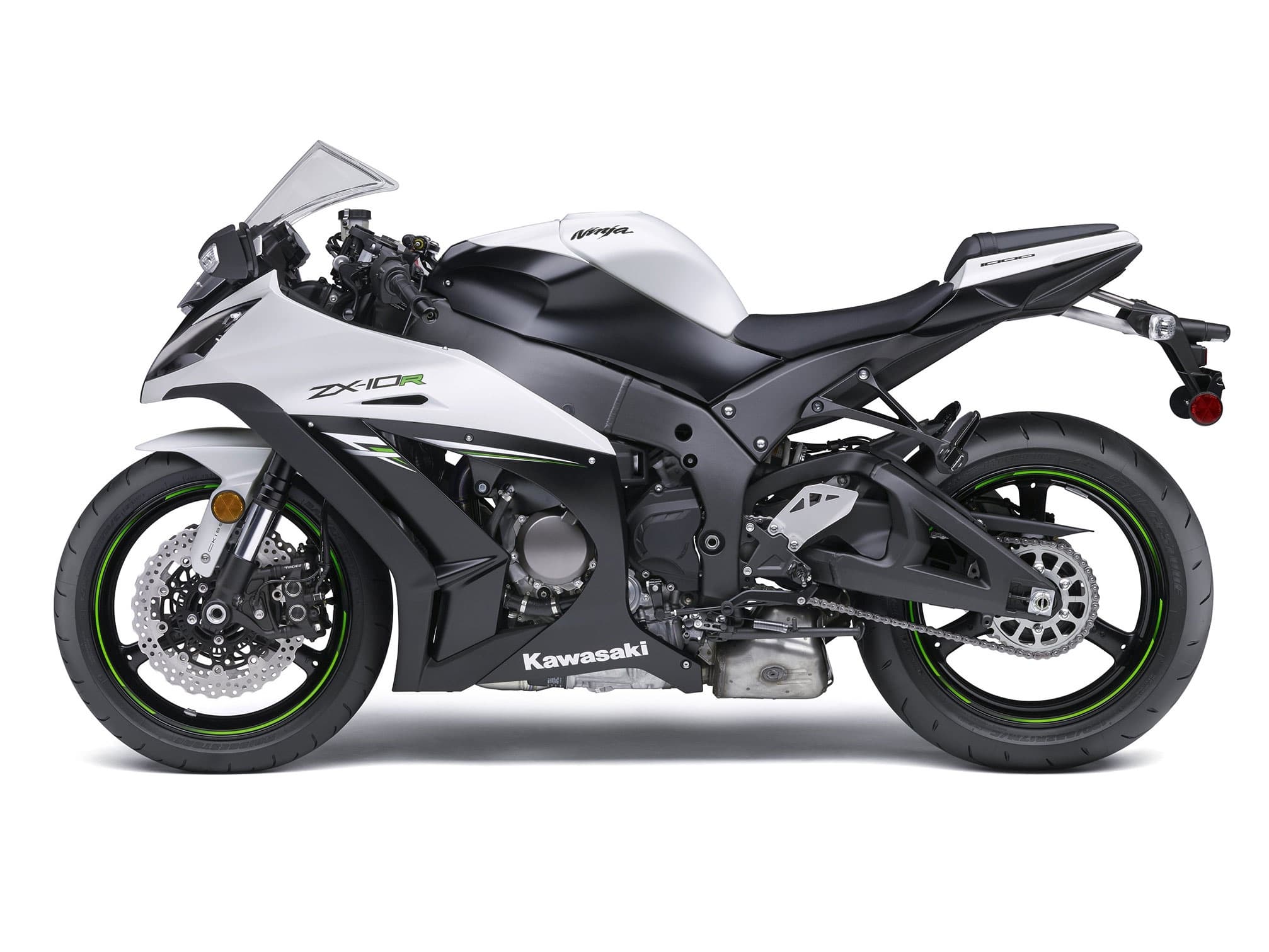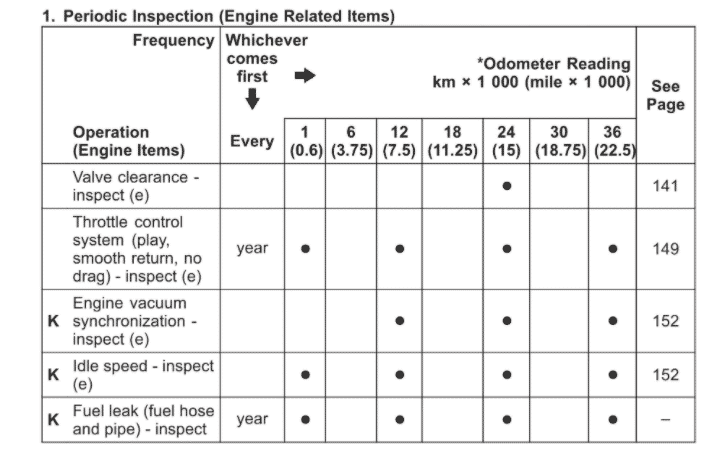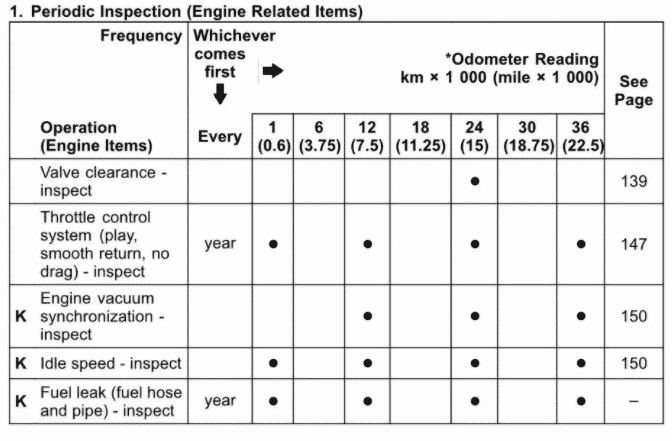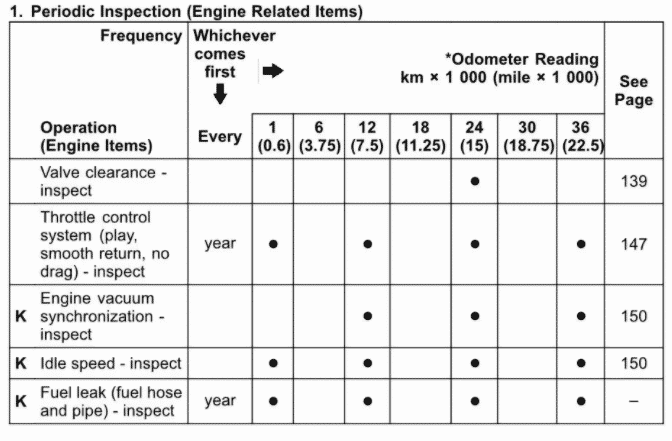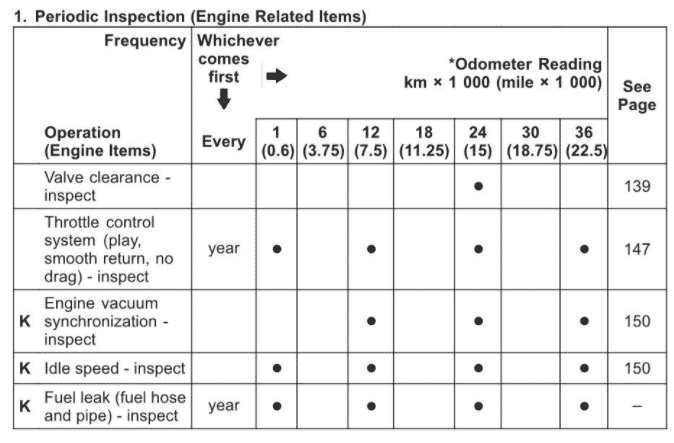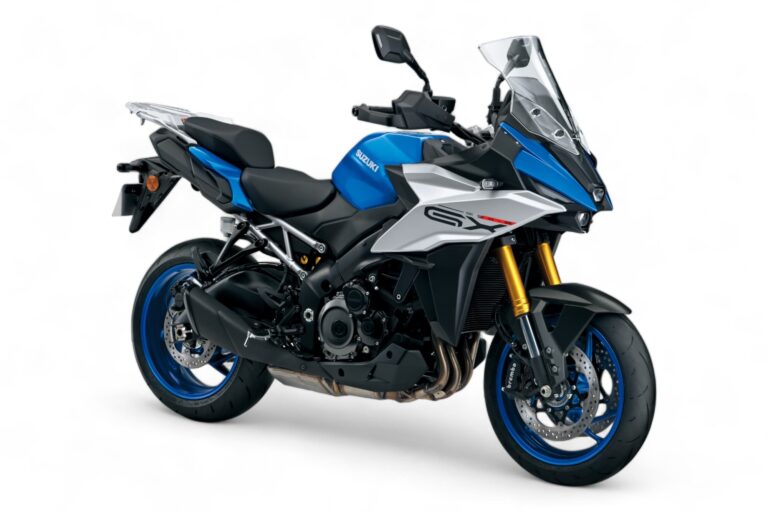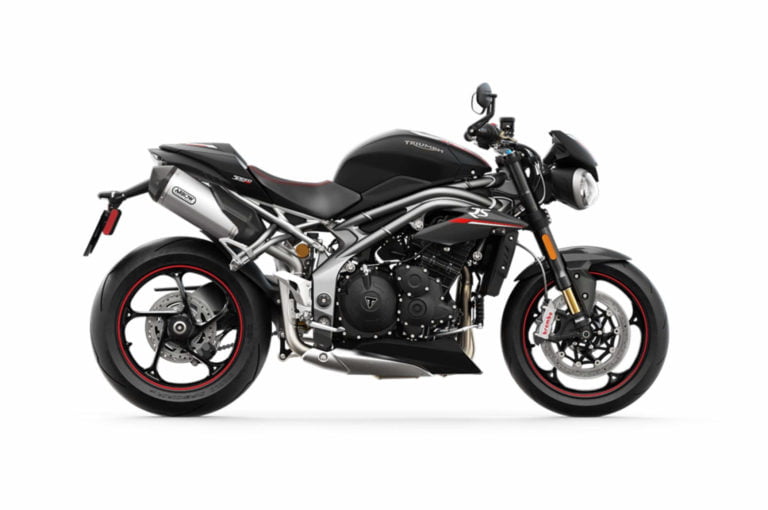Kawasaki Ninja ZX-10R Gen 4 (2011-2015) Maintenance Schedule and Service Intervals
This is the maintenance schedule with associated service intervals for the Kawasaki Ninja ZX-10R Gen 4 (a.k.a. “Kawasaki ZX10R”) made between 2011-2015, including the 30th anniversary model.
The Kawasaki Ninja ZX-10R is a /superbike in the Ninja series, the successor to the Ninja ZX-9R. Kawasaki originally released the ZX-10R in 2004 and has updated and revised it throughout the years.
Kawasaki’s engineers used a stacked design for a liquid-cooled, 998 cc inline four-cylinder engine. In the 2011-2015 version, the Kawasaki Ninja ZX-10R makes 140-150 kW (188-200 hp) @ 12500 rpm (the higher numbers being with ram air) putting it at a similar level to the top of the class.
This site has links for things like oil and spark plugs from which we earn a commission (which unfortunately nobody can save, not even us). If you appreciate this work, then please use those links. Thanks!
Kawasaki Ninja ZX-10R Service Intervals
The Kawasaki ZX-10R has 7500 mile / 12000 km or annual service intervals. At every service, change the oil and filter, as well as the spark plugs.
Every 15000 miles / 24000 km, inspect the valve clearances. The first inspection of this kind is the most imperative; as time goes on, fewer and fewer valves are out of clearance (but still, it should be done).
Regularly change your brake fluid and engine coolant.
You should regularly check and adjust the drive chain wear and slack, especially if you track your ZX-10R. See below for guidance on how to do it.
Kawasaki ZX-10R Generations
Before you ask “Why is this a such-and-such ZX-10R”, here are the generations of the ZX-10R, according to obsessive forum people, and also Wikipedia.
- Kawasaki ZX-10R Gen 1 (C1-C2, 2004-2005): Dry weight 170kg, 130 kW (175 hp) @ 11,700 rpm. Brakes are 300mm dual radial-mounted discs with four-piston calipers.
- Kawasaki ZX-10R Gen 2 (D1-D2, 2006-2007): Dry weight 174 kg, power 130 kW (175 hp) @ 11,700 rpm. A make-over that smoothed out the Gen 1 (with otherwise the same engine) with different injectors, heavier flywheel, and an under-seat exhaust. The “least desirable” ZX-10R per forums. Same brakes as Gen 1.
- Kawasaki ZX-10R Gen 3 (2008-2010): Dry weight 179 kg, 140-150 kW (188-200 hp) @ 12,500 rpm, going up with ram air. Longer wheelbase, extended rake, black fork tubes, Öhlins steering damper, adn new bodywork. Brakes upgraded to 310mm petal discs
- Kawasaki ZX-10R Gen 4 (2011-2015): Dry weight 187 kg, 150 kW (200 hp) @ 13,000 rpm (with ram air). Revised porting, higher lift cams, and higher compression. New twin-spar frame with horizontally-mounted shock. KTRC traction control, power modes, and optional ABS (a rarity on superbikes at the time). Big Piston fork suspension, replacing regular inverted forks. Same brakes as Gen 3.
- Kawasaki ZX-10R Gen 5 (2016-2020): 148 kW (197 hp) with ram air @ 13,000 rpm. An IMU giving lean angle-aware ABS and traction control. Launch control mode, quickshifter, and engine brake control. Also slipper clutch, and lighter engine components. Less restrictive air filter and exhaust. Brakes are 330mm circular discs with Brembo M50 monoblock calipers. Balance Free Fork suspension.
- Kawasaki ZX-10R Gen 6 (2021+): 150 kW / 204 hp @ 14000 rpm, or 157.5 kW / 214 hp with ram air. Higher power through a high-speed valvetrain, more aggressive cam profile, air-cooled oil cooler, electronic throttle valves and valve train (allowing the bike to rev higher), gearbox ratios changed for shorter gears 1-3, electronic cruise control, TFT display, Bluetooth connectivity, integrated winglets and a more aerodynamic front cowl (more downforce, less drag), LED headlights and tail-lights
What you need to service the Gen 4 Kawasaki Ninja ZX-10R
If you’re servicing your ZX-10R, aside from some basic motorcycle maintenance tools, you’ll need the following items.
| Item | Kawasaki ZX-10R (Gen 4) spec |
|---|---|
| Engine oil | Kawasaki recommends an SAE 10W-40 oil that meets API SG or higher / JASO MA or higher rating, e.g. Kawasaki Performance engine oil. Another high-quality oil is Motul 7100 10W-40. |
| Oil filter | The Kawasaki ZX-10R has taken a Hiflofiltro HF303RC since 2006. |
| Spark plug | Use an NGK CR9EIA-9 spark plug. The gap must be 0.8-0.9mm and it must be tightened to 13 Nm (9 ft-lb). |
| Air filter | The 2011-2015 ZX-10R takes a K&N KA-1011 air filter. |
| Coolant | The manual recommends a “permanent type of antifreeze” based on ethylene glycol (at 50%) with rust inhibitors for aluminium engines and radiators. A good easy-to-get replacement is Pro Honda Coolant, which meets this spec. |
| Brake fluid | Use a high-quality synthetic e.g. Castrol DOT 4. |
| Brake pads | Two pairs of FA379HH up front, and FA192HH at the rear. |
| Lubricant | For external lubricant, use Valvoline Liquid Moly Fortified Grease, a high-quality lubricant. |
| Chain maintenance | Use Motul chain paste for chain maintenance — a highly recommended, affordable, and good quality product. |
| Battery | Dead battery? Your ZX-10R takes a YTZ10S. |
Maintenance Schedule for Kawasaki Ninja ZX-10R
Below is the maintenance schedule for the 2011-2015 Kawasaki Ninja ZX-10R Gen 4.
- For higher odometer readings, repeat at the frequency interval established here.
- Follow the earlier of time-based or distance-based service intervals
- Kawasaki recommends items relating to emissions or safety be serviced by an authorised dealer.
- Service the oil, chain, and brakes more often if riding in dusty, wet, muddy, or aggressive riding conditions.
- Service the brakes and steering damper in between service intervals
Service schedule
| km x 1000 | 12 | 24 | 36 | 48 | |
|---|---|---|---|---|---|
| mi x 1000 | Every | 7.5 | 15 | 22.5 | 30 |
| Annual inspection checklist (see below) — Inspect all items | year | ✓ | ✓ | ✓ | ✓ |
| Engine oil – change (Motul 7100 10W-40) | year | ✓ | ✓ | ✓ | ✓ |
| Oil filter – replace (HF303RC) | year | ✓ | ✓ | ✓ | ✓ |
| Spark plug – replace (CR9EIA-9) | ✓ | ✓ | ✓ | ✓ | |
| Valve clearance – inspect | ✓ | ✓ | |||
| Air cleaner element – replace (KA-1011) | 18000 km (11250 mile) | ||||
| Engine vacuum synchronization – inspect | ✓ | ✓ | ✓ | ✓ | |
| Idle speed – inspect | ✓ | ✓ | ✓ | ✓ | |
| Fuel hoses – replace | 5 years | ||||
| Coolant – change (Pro Honda Coolant) | 3 years | ✓ | |||
| Radiator hoses and O-rings – replace | 3 years | ✓ | |||
| Brake hoses – replace | 4 years | ✓ | |||
| Brake fluid (front and rear) – change (Castrol DOT 4) | 2 years | ✓ | ✓ | ||
| Steering stem bearings – lubricate | 2 years | ✓ | ✓ | ||
| Rubber parts of master cylinder and calipers – replace | 4 years | ✓ |
Inspection checklist
Below is a checklist of items to look over on the Kawasaki ZX-10R.
| Annual inspection checklist — Kawasaki ZX-10R |
|---|
| Clutch operation (play, engagement, disengagement) – inspect |
| Drive chain wear – inspect |
| Drive chain guide wear – inspect |
| Tire air pressure – inspect |
| Wheels/tires damage – inspect |
| Tire tread wear, abnormal wear – inspect |
| Wheel bearings damage – inspect |
| Brake fluid leak – inspect |
| Brake hoses damage – inspect |
| Brake pad wear – inspect |
| Brake hose installation condition – inspect |
| Brake fluid level – inspect |
| Brake operation (effectiveness, play, drag) – inspect |
| Brake light switch operation – inspect |
| Front forks/rear shock absorber operation (damping and smooth stroke) – inspect |
| Front forks/rear shock absorber oil leak – inspect |
| Rocker arm operation – inspect |
| Tie rods operation – inspect |
| Steering play – inspect |
| Steering damper oil leak – inspect |
| Lights and switches operation – inspect |
| Headlight aim – inspect / adjust |
| Side stand switch operation – inspect |
| Engine stop switch operation – inspect |
| Chassis parts – lubricate (Lithium soap-based grease) |
| Bolts and nuts tightness – inspect |
| Evaporative emission control system – function check (if fitted) |
Maintaining Your Chain on the Kawasaki ZX-10R (4th gen)
It’s important to maintain your chain on the ZX-10R (4th gen), as on any chain-driven motorcycle. Use a good-quality chain lubricant like Motul chain paste, or a Motul chain care kit which comes with a couple of handy tools to maintain the chain.
Kawasaki recommends you follow the following chain maintenance schedule:
| Chain maintenance item | Every |
|---|---|
| Check drive chain lubrication condition, lubricating if necessary (Motul chain paste) | 400 mi / 600 km |
| Check drive chain slack, adjusting if necessary (See below for notes) | 600 mi / 1000 km |
Notes:
- Do these items (checking/adjusting slack, and checking/applying lubrication) more often if you ride your ZX-10R in dusty or rainy conditions.
- Always lubricate the chain after washing the motorcycle.
Checking chain slack
To check the slack on the Kawasaki Ninja ZX-10R, put the motorcycle in neutral, onto its kickstand, and on a level surface.
Check the slack on the lower part of the chain, midway between the sprockets, and check it in multiple places (move the motorcycle forwards and backwards) as chains wear unevenly.
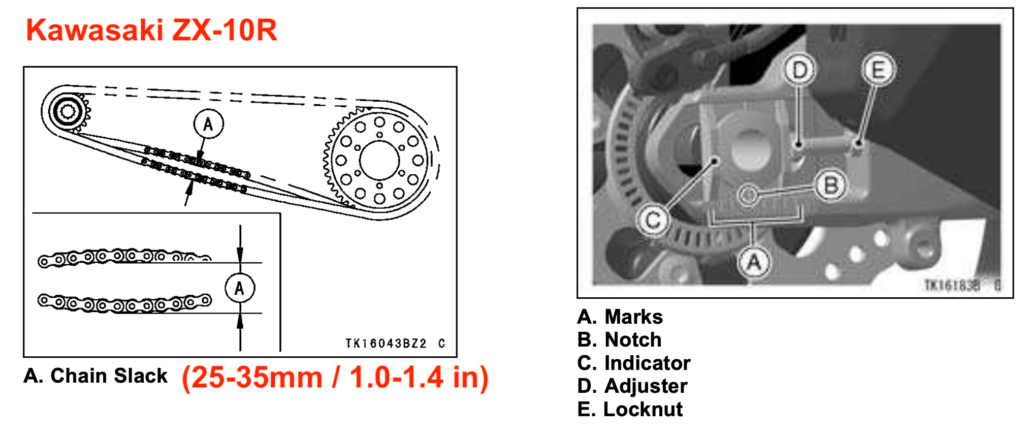
Slack on the Kawasaki Ninja ZX-10R is defined as the free vertical movement of the chain.
Target chain slack for the Ninja ZX-10R: 25-35mm (1.0-1.4 in)
If the chain slack is out of spec, you need to adjust it.
Adjusting chain slack
To adjust the chain slack on the ZX-10R, follow the steps below. As with measuring chain slack, make sure that the motorcycle is on a level surface on its kickstand, in neutral, with no weight on it (no saddlebags / luggage).
- Loosen the rear axle and the adjuster lock nuts on either side of the axle.
- Turn the adjuster nuts to tighten (or loosen) the chain. Keep checking the chain tension to see if it has come within spec. (Target chain slack for the ZX-10R: 25-35 mm / 1.0-1.4 in)
- Keep an eye on the adjuster alignment marks on either side of the axle. Make sure that the adjustment is to the same point.
- When you’re done, tighten the axle to 127 Nm / 94 lb-ft.
- Re-check the chain slack again to make sure it’s still within spec.
Tyre size and tyre pressure for the Kawasaki Ninja ZX-10R
The Kawasaki Ninja ZX-10R Gen 4 has the following tyre sizes and recommended pressures as standard.
| Tyre | Size | Tyre pressure |
|---|---|---|
| Front | 120/70 ZR17 M/C (58W) | 250 kPa/36psi |
| Rear | 190/55 ZR17 M/C (75W) | 290 kPa/42psi |
The Gen 4 ZX-10R shipped with Bridgestone Battlax BT016 tyres. But you can use any sport/sport-touring tyres.
About the Kawasaki Ninja ZX-10R Gen 4
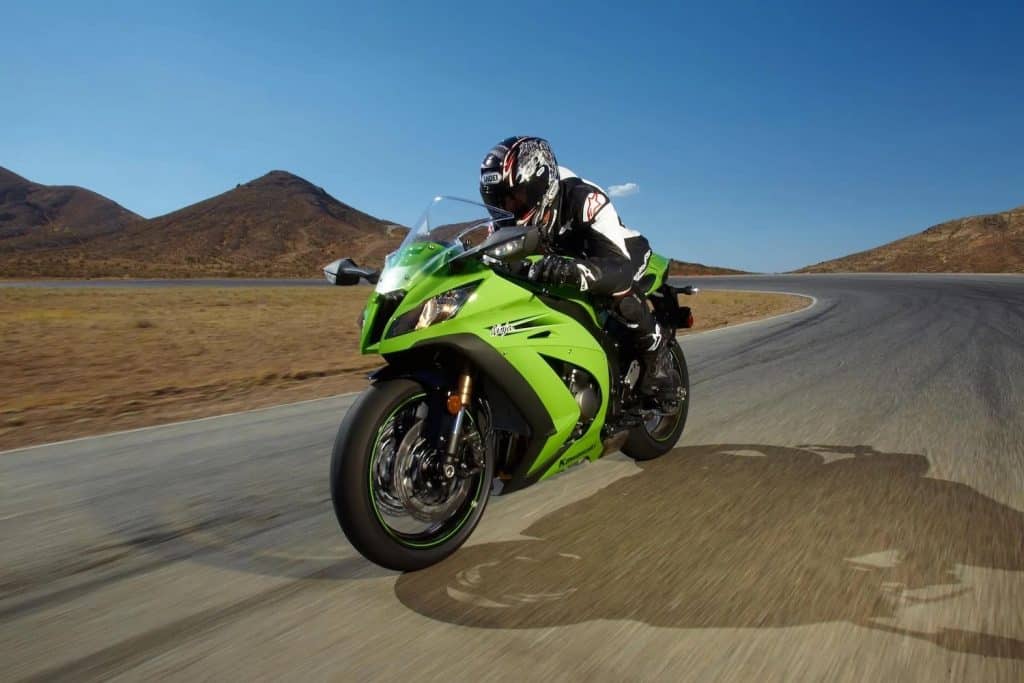
The Ninja ZX-10R Gen 4 is the latest in a series of superbikes that Kawasaki had been building since 2004, replacing the previous ZX-9R.
Like the previous Kawasaki Ninja ZX-10R bikes before it, the Gen 4 is a “liter”-class superbike — based on a 998cc liquid-cooled dual overhead-cam inline four-cylinder engine.
In terms of public brand recognition is a quiet achiever in the world of superbikes. Their brand isn’t as well known — maybe because they don’t have the marketing panache of Ducati or a catchy name like Fireblade.
But the ZX-10R is as competent as any of those brands — and more so. In fact, in recent years, Kawasaki has had more World Superbike wins than any of the other brands.
In 2011, Kawasaki made some significant updates to the ZX-10R.
Firstly, Kawasaki has heavily revised the engine. They replaced the camshafts, making them out of chromoly steel rather than cast iron, and increasing the cam lift and valve overlap, in a move to increase peak power.
The valve tappets were designed to work with the new high-lift cams, and the valve diameter was replaced.
Kawasaki also increased volume of the intakes and changed the porting of both the intakes and exhausts. Lighter weight pistons help Kawasaki improve compression ratio from an already high 12.9:1 to 13.0:1, moving the redline up to 14500 rpm, a massive change from the earlier 13000 rpm.
The result is an engine that produces 147 kW (200 hp) at 13000 rpm — if you ever get there in day-to-day riding!
Kawasaki also implemented an extensive (for the time) electronic control system.
The 2011-2014 Kawasaki ZX-10R comes with traction control (K-TRC) and optional ABS (K-IBS). This was pretty new for the time — the 2009 BMW S 1000 RR was leading the way, and the Japanese brands were playing catch-up (Honda had optional ABS on the Fireblade but it was not a commonly chosen option).
Unlike many earlier motorcycles, traction control and ABS on the Gen 4 ZX-10R (the first generation to have these features) are unobtrusive and just do their job without you noticing. And if you’re really keen, you can modulate the intervention level of the TC. Level 1 is the fun one, and Levels 2 and 3 are increasingly “please, be gentle”.
You can also change power modes — Kawasaki has implemented three of them on the Gen 4. There’s Full, Medium, and Low.
Kawasaki also updated the forks and rear shock on the ZX-10R. The Gen 4 Kawasaki ZX-10R has 43mm Big Piston Forks with a DLC coating for less friction.
The rear shock is now horizontally mounted, and is a fully adjustable unit.
The most incredible thing about the Kawasaki ZX-10R Gen 4 is the weight — it’s just 198 kg (436 lb) wet, giving the bike a better power-to-weight ratio than the BMW S 1000 RR.
Manual for the Kawasaki Ninja ZX-10R Gen 4
The above maintenance schedule comes directly from the user’s manual for the 2013 Kawasaki Ninja ZX-10R, which is available here.
